Bounce theory
I imagined subatomic particles interacting with each other within the diffuse confines of nuclei.These atomic entities occupy space-time by engaging in oscillatory activity. One could say they are "bouncing" in space-time.
Imagine a balloon that has been filled with small, light plastic balls. The balloon is then inflated and placed under a piece of cloth that is in constant oscillation. The oscillations of the cloth produce small jumps in the balloons, which in turn produce movement of its inner elements. The angle, force and frequency of bounces of the balloons on the cloth would all determine the position of the smaller elements. The combination of the aforementioned variables is non-deterministic, but the individual principles involved in the oscillation of the cloth, the bounce of the balloon, and the movement of its inner particles, are deterministic.
The principles that determine the motion of subatomic particles are deterministic, but the "bounces" aren't, because the fabric of space-time oscillates as well, making the point of bounce random. This could account for why deterministic principles are hard to apply to the measurement of position in time and space of subatomic particles. We are not taking into account the "bounce"

































